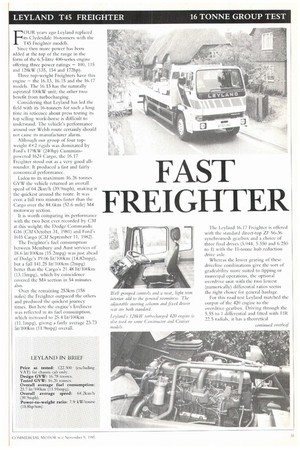FAST FREIGHTER
Page 37

Page 38

If you've noticed an error in this article please click here to report it so we can fix it.
FOUR years ago Leyland replaced its ciydes.„ 16-tonnerS with the T45 Freighter models.
Since then more power has been added at the top of the range in the form of the 6.5-litre 400-series engine offering three power ratings — 100, 115 and 128kW (135, 154 and 172hp).
Three top-weight Freighters have this engine — the 16.13, 16.15 and the 16.17 models. The 16.13 has the naturally aspirated 100kW unit; the other two benefit from turbocharging.
Considering that Leyland has led the field with its 16-tonners for such a long time its reticence about press testing its top selling work-horse is difficult to understand. The vehicle's performance around our Welsh route certainly should not cause its manuflicturer alarm.
Although our group of four topweight 4x2 rigids was dominated by Ford's 179kW (240hp) Cumminspowered 1624 Cargo, the 16.17 Freighter stood out as a very good allrounder. It produced a fast and fairly economical performance.
Laden to its maximum 16.26 tonnes GVW the vehicle returned an overall speed of 64.2km/h (39.9mph), making it the quickest around the route. It was even a full two minutes faster than the Cargo over. the 84.6km (52.6 mile) M4 motorway section.
It is worth comparing its performance with the two best ever recorded by CM at this weight; the Dodge Commando GI6 (CM October 31, 1981) and Ford's 1615 Cargo (CM September 11, 1982).
The Freighter's fiael consumption between Membury and Aust services of 18.6 lit/100km (15.2mpg) was just ahead of Dodge's 19.06 lit/100km (14.82mpg), but a full 141.25 lit/100km (2mpg) better than the Cargo's 21.48 lit/100km (13.15mpg), which by coincidence covered the M4 section in 54 minutes also. .
Over the remaining 253km (158 miles) the Freighter outpaced the others and produced the quickest journey times. But here the engine's liveliness was reflected in its fuel consumption, which increased to 25.4 lit/100km (11.1mpg), giving a fairly average 23.73 lit/1110km (11.9inpg) overall.
The Leyland 16.17 Freighter is offered with the standard direct-top Z.F 56-36 synchromesh gearbox and a choice of three final drives (5.044, 5.550 and 6.250 to 1) with the 11-tonne huh reduction drive axle.
Whereas the lower gearing of these drivehne combinations give the sort of gradeahility more suited to tipping or in operations, the optional overdrive unit with the two lowest (numerically) differential ratios seems the right choice for general haulage.
For this road test Leyland matched the output of the 420 engine to the overdrive gearbox. Driving through the 3.55 to 1 differential and fitted with Ilk 22.5 radials, it has a theoretical
maximum geared speed of Illkm/h (69mph).
On the motorway the engine works hard at 2,200rpm to maintain the 96.5km/h (60mph) limit, but running between 64km/h (40mph) and 80km/h (50mph) on A-roads brought the revs closer to 1,600rpm. This is where its 574Nin (4231h1t) maximum torque occurs.
At this end of its CV range Leyland omit to colour code the rev counter on what is a standard T45 instrument panel on the grounds that there arc too many engine and power variations w make it viable. This is a great shame as most HGV drivers use it instinctively to ensure that the engine is working within the optimum rev band and to compare engine speeds with road speed limits.
For the chassis high-tensile steel channelling is used for the flat topped, bolted and riveted frame. On assembly it is pre-stressed and drilled out to allow most types of body to he fitted without the need for anything more than a fairly simple sub-frame.
Leyland thoughtfully folds-in an extra two metres of lighting harness at the rear of the chassis to eliminate the need to break into the wiring at the bodybuilders.
Another consideration as far as downtime is concerned is the extended tacho Iced into the gearbox which makes clutch changes possible without having to disconnect the drive and re-calibrate the unit.
Including the sleeper cab the unbodied 16.17 on its 6.06m (239in) wheelbase weighs 4.9 tonnes. This gives an 11.36tonne payload including body allowance.
Tapered two-leaf semi-elliptic front springs and five leaf rear springs with slippered helper packs give a well controlled but fairly hard ride around the winding A-class roads. This would have been eased if an optional suspended scat had been specified instead of the standard version. The effect is heightened by the acute angle of the accelerator which makes it impossible to control comfortably with the foot fully down on it. With just the slightest pressure on the pedal, any severe bump causes the engine to jerk and the vehicle to start bouncing.
Otherwise, the vehicle handles easily, with power assisted steering which Wantage's tight one-way system showed to be precise.
A light air-assisted clutch pedal makes gear changing crisp and effortless, and the full-air brakes, despite being
sensitive initially on our vehicle, respond extremely well.
The Freighter's well appointed cab has a low engine tunnel and its dashboard is not as deep as most. This makes the sleeper version feel very roomy inside. Interior noise levels of 73 and 75 dB(A) at 64km/h (40niph) and 97km/h (60mph) add to the driver's general comfort.
, Forward and side visibility is generous, and the large nearside mirror compensates for the restrictive corner panel behind the passenger door.












































































































































